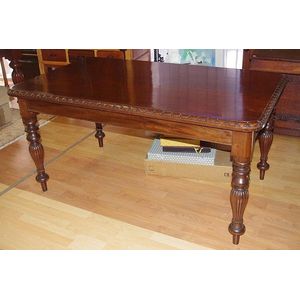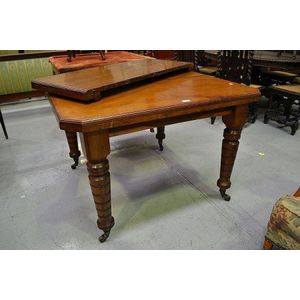Regency Mahogany Secretaire/Work Table
Fine late Regency secretaire/work table in mahogany with curled decoration to the top, pull out drawer with writing slope, fitted with sewing bag, well carved supports on gadrooned platforms with claw feet English 1830's
You must be a subscriber, and be logged in to view price and dealer details.
Subscribe Now to view actual auction price for this item
When you subscribe, you have the option of setting the currency in which to display prices to $Au, $US, $NZ or Stg.
This item has been sold, and the description, image and price are for reference purposes only.
- Mahogany - Mahogany is a dense, close grained red-coloured timber from the West Indies and Central America. It was first imported into Europe in the the early 18th century and its use continued through the 19th century. It was popular for furniture making because of its strength, the wide boards available, the distinctive grain on some boards, termed flame mahogany and the rich warm colour of the timber when it was polished.. The "flame" was produced where a limb grew out from the trunk of the tree, and this timber was usually sliced into veneers for feature panels on doors, backs and cornices.
Some terms used to describe mahogany relate to the country from which it originally came, such as "Cuban" mahogany, "Honduras" mahogany etc. However unless the wood has been tested the names assigned are more a selling feature, rather than a true indication of the timber's origin. - Regency Period - The Regency period in English furniture design refers to the period when King George III, was declared unfit to rule in 1811, and his son ruled as proxy as Prince Regent, until 1820, and then, after the death of his father as George IV until his death in 1830. The Regency period was preceded by the Georgian period (George I, George II, and George III: 1714 - 1811), and was followed by the William IV period, which only lasted until 1837 when William IV died as was succeeded by Queen Victoria.
- Gadrooning - A series of lobes usually as a border. In furniture gadrooning is found as carved decoration around the edges of table tops in the Chippendale and Jacobean style furniture. Gadrooning is also found as decoration on the rims of silver and ceramics.
- Claw Feet - Carved or cast in the shape of a lion's claw or the talons of other more fabulous beasts. They may be found on chair and table legs, supporting platform bases, and cabinets in the Classical Revival manner. Claw feet are not uncommon on Australian furniture made throughout the 1850s and 1860s, though, as with all forms of carving, the deeper and richer the claws are carved, the earlier the piece is likely to be.
This item has been included into following indexes:
- tables, purpose or type - sewing and work 357
- tables, small, period or style
Visually similar items

Vintage cedar dining table on turned reeded legs, 152 x 88 cm, 75 cm high
Sold by
in
for
You can display prices in $Au, $US, $NZ or Stg.

Good vintage French oak three drawer table desk, 180 x 88 cm
Sold by
in
for
You can display prices in $Au, $US, $NZ or Stg.

Antique Gothic rectangular hall table, turned legs, fitted with a single drawer at one end, approx 75 cm high, 120 cm wide, 43 cm deep
Sold by
in
for
You can display prices in $Au, $US, $NZ or Stg.

Antique walnut turned leg extension dining with one leaf table, 146 cm extended x 104 cm wide
Sold by
in
for
You can display prices in $Au, $US, $NZ or Stg.
